HMOs and Return on Investment

Why consider a HMO as an investment option?
A HMO can be a lucrative source of income for you if you find yourself in the fortunate position of owning or inheriting a property that is suitable for HMO conversion, or if you are looking to expand your property portfolio. The key question to ask is how? At Reka, we know the answer because we found ourselves with a home that was perfect for HMO conversion and was, in fact, the reason behind why Reka Property Management exists. We impart our knowledge below:
1. What exactly is a HMO?
Let’s start with the basics. A HMO stands for House in Multiple Occupation. This has to be a property that is shared by multiple tenants at the same time, normally at least three people, who are not related, but do share communal facilities such as the kitchen and bathroom. Each tenant has their own separate bedroom and their own contract. Most rental payments also include their bills, so it is a clear and straightforward amount for the tenant to pay and offers them the security of knowing what they will be paying without the responsibility of dealing with bills etc.
2. What characterizes a HMO?
- It is often the main residence of the tenant
- Tenants pay rent
- There are three of more tenants living there
- They do not form a single household
3. Where, and what building, should you consider for maximum HMO investment?
Any properties that are in high rental areas are ideal as HMOs. Examples of this are areas near universities, to attract students, or major cities where the ease of renting suits many. Old police stations, halls of residences, pubs and GP surgeries make perfect HMO conversions.
4. How to convert a property into a HMO.
As mentioned earlier, you will need to make each bedroom the tenant’s ‘own’ space and this normally means putting locks on each bedroom door. You may wish to configure each bedroom, move walls or convert the garage. You will also need to send the council your updated gas certificate, install and maintain smoke alarms and produce safety certificates for all electrical appliances. You may also require planning permission, so it is prudent to check before you begin any work. According to the regulations for General Permitted Development Order (GDPO) you will also need to change the use of the property from a C3 dwelling house to a HMO C4 status type and obtain a HMO license.
As you can see the list is long, time consuming and can be arduous.
However, we have decades of experience in this area and can help you navigate your way through this, especially as some councils are issuing fines of up to £20,000 for HMO licensing non-compliance.
5. How do HMOs make money?
There is simple maths behind why a HMO with multiple tenants is more lucrative than one tenant in the whole house. More tenants, equals more rent. It is also more profitable than a standard Buy To Let for obvious reasons. We have seen cases where revenue has increased by up to 300% to 400% when compared with a standard Buy To Let.
It also spreads the risk of tenants in arrears. The old adage ‘putting all your eggs in one basket’ applies here. Renting your property to one tenant means that you are dependent on them to pay ALL the rent. It is unlikely that all your tenants default on their rent at the same time. This diversification of tenants also means that if one moves out, you still have a solid base of tenants paying their rent. The chances of everyone moving out at the same time would be unusual.
Hopefully this has given you some information around HMOs and if you are keen to convert your property to one, or wish to expand your property portfolio to include HMOs, then please do get in touch.


